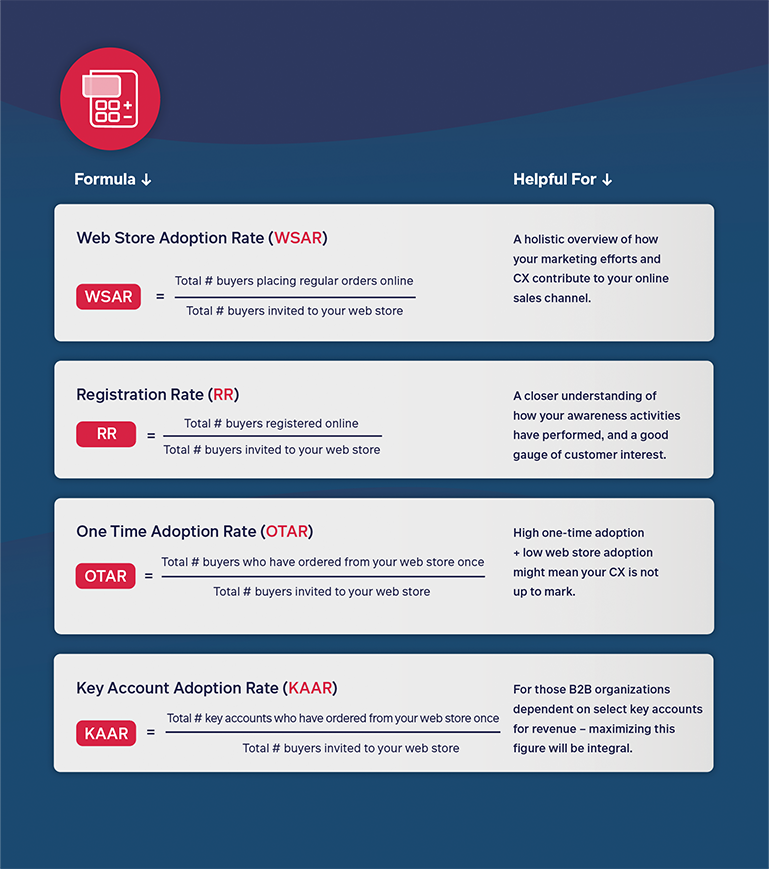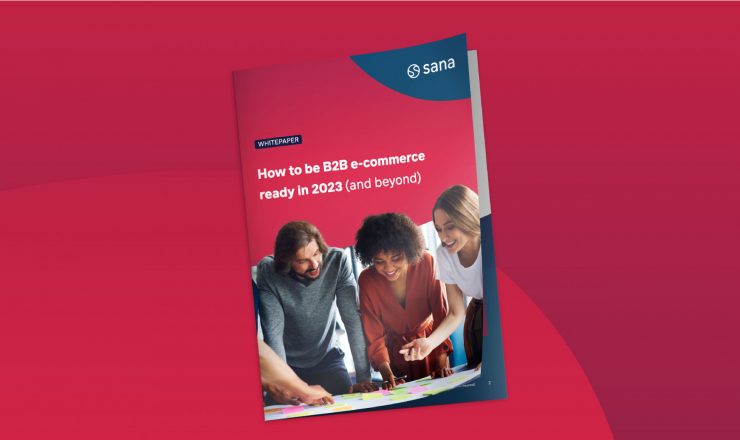

What are KPIs in B2B e-commerce and why do they matter?
KPIs (key performance indicators) can be defined as metrics that are crucial for determining the progress and success. In this case, we will be discussing how they relate to a your B2B online web store.
They force you to think about the true impact of e-commerce on your business. By setting and measuring KPIs, you can tangibly assess where your strengths and weaknesses lie and where you should be heading next. Which also helps contribute to making informed future-proof business strategies.
7 B2B e-commerce KPIs that can help you track your web store’s success
E-commerce KPIs can include metrics such as traffic volume, conversion rates, average order value, and retention rates. The KPIs you select should align with your overall business and e-commerce goals.
For example, is your goal to increase B2B customer satisfaction?
KPIs such as retention rates and return visits can help you assess how well you are performing. Or perhaps your goal is to focus on increasing e-commerce sales? Then choose KPIs such as number of online orders and average order value.
Companies that sell to professional buyers online can benefit from targeted, B2B-specific metrics centered around such goals as boosting revenue, retaining customers, increasing efficiency, and more.
KPI 1: Online customer retention rate (CRR)
This B2B online sales KPI lets you pinpoint ways you can improve your B2B customers’ buying experience and drive repeat business.
Most of our own customers tell us that their B2B e-commerce platform is an alternative to other sales channels, so they want to compare how customers shift between various channels on an individual level.
For example, if individual customers place orders online more frequently than before, this could indicate that your web store effectively fulfills their needs. But if customers shift back to offline ordering after the initial use of your B2B e-commerce platform, this could mean that the web store is falling short and requires improvement.
KPI 2: Return rate
Repeat purchases measure who are returning customers and are often an important B2B e-commerce KPI for B2B sales. This B2B KPI indicates how well your sales portal is meeting needs beyond just placing orders.
The difference between selling online to consumers (B2C) and professional buyers (B2B) is that in a closed B2B web store, a visitor is always a customer — not just a casual visitor looking at ten different web stores at the same time. If a customer keeps visiting your online portal it means that it serves a purpose for them.
Read more about essential features your organization could make use of to keep your customers coming back.
KPI 3: Customer satisfaction
The adoption of online tools to measure customer satisfaction isn’t as widespread among wholesalers, manufacturers, and distributors as it is among B2C retailers. This makes measuring customer satisfaction a bigger challenge. But it also means these B2B companies can realize a quick win by implementing online tools that let them efficiently measure and report on customer satisfaction.
This isn’t the only way you can keep track of customer satisfaction. Because relationships with B2B buyers are generally more personal than in B2C, you can conduct in-depth interviews to learn more about the why and how of the online shopping experience. Be sure to utilize that relationship as it has proven to be a valuable source of ideas for improving the overall value and success of your B2B e-commerce platform. Want more tips on how you can provide your customers with excellent experience in the digital age?
Read more about how to capture B2B customer feedback to improve your B2B e‑commerce experience.
KPI 4: Online order frequency
This KPI indicates to what extent an online sales portal is improving the efficiency of your sales and customer support teams. For many of our customers, B2B e-commerce is not so much about the percentage of online revenue, but rather about the percentage of orders placed online.
Although small orders combined are often a crucial part of any business, they take a lot of time to process offline and therefore tie up a relatively big chunk of your resources. If these orders can be placed online directly by your customers, this will have a positive effect on the workload of your sales and support teams.
A B2B e-commerce platform frees up your sales team to handle other client requests, including assistance with larger orders. This lets you increase the number of orders you can process without increasing your staff.
To determine the profitability of adding an online sales channel, it’s critical to measure online order frequency and compare it to your total amount of orders.
KPI 5: Average conversion rate
When you require your customer to make a purchase at the end of their buyer journey, it’s important to identify the percentage of users completing this cycle. This KPI also allows you to determine whether buyer behavior changes according to changes in your webstore.
To calculate conversion rate, here is a simple formula: Conversion rate = Total visitors/number of conversion x 100.
What makes this B2B online sales KPI different from the well-known B2C version?
B2B businesses not only have the ability to compare this KPI with other points in time but also on an individual level and in comparison with offline orders placed by the same customer. This B2B e-commerce KPI should indicate whether you are capitalizing on the cross-sell and upsell potential of your e-commerce platform. It will also let you know how easy it is to navigate through products on your web store.
KPI 6: Website traffic
This click ratio holds the key to successful conversions, shedding light on your landing page’s overall effectiveness. However, it’s important to remember that the CTR can be influenced by various factors, such as the time of day and the demographic makeup of your audience.
In B2B e-commerce, an interesting KPI is looking at orders placed outside normal office hours. This clearly indicates that you are fulfilling a need for your customers and builds your case for continuing to invest in your online business. This also may indicate if your target audience resides outside of your time zone. This means you can optimize your marketing spend by prioritizing your frequent buyers.
A more challenging metric is the average order value of customers who conduct online research before placing their orders offline. By comparing the average order value of these orders with the average order value of offline customers who don’t do online research, you can determine whether your B2B web store provides the right information about your assortment or specific products.
KPI 7: Adoption rate
Are your customers actually using your webstore as a single source of truth? B2B e-commerce adoption refers to the rate at which your customers rely solely on your web store to execute orders and gather key information.

Calculating your web store adoption rates helps impart valuable insights into how your online channel is performing for your organization. To read more about adoption rate, see an in-depth report in The Essential B2B E-Commerce Adoption Guide: How to Keep Customers Coming Back
The benefit of monitoring B2B-specific e-commerce KPIs
With these targeted B2B e-commerce KPIs for online sales, it should be easier to keep an eye on both the details and the bigger picture. Keeping track of B2B e-commerce metrics not only lets you see the return on your investment, but it also helps you recognize trends. Trends that you can then capitalize on to get more customers ordering online, and with increased frequency.
Want to know more about B2B e-commerce trends, buyer behaviors, and challenges? Download our 2022 research report below to learn how businesses are addressing customer demands by filling offline sales gaps with e-commerce, and in turn, how the e-commerce market is fundamentally changing B2B businesses.

How to meet buyers’ demand for (better) B2B e-commerce
The B2B buying process report



